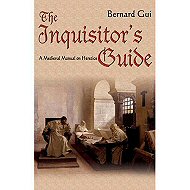|
The Inquisitor's Guide: A Medieval Manual on Heretics
|
|
Bernard Gui
|

|

* How to outwit heretics and pass judgment upon them
* An insider's view of the infamous inquisition in the early 1300s, when it
was active in the suppression of heretics (from Cathars to False
Apostles), Jews and converted Jews, secret sects, cults, schismatics
and sorcerers.
* Written in the 1320s, available for the first time in English.
The fourteenth century would see Europe wracked by upheaval, war, rebellion, famine and plague. To many it seemed as though society itself was breaking apart, a true age of apocalypse.
No institution was above the tumult. The Church, which had survived critics and outlived sects, found itself under virulent attack form heretics. It countered with the inquisition, an embryonic police state and one of the most effective and brutal organizations ever created.
Bernard Gui (or Guidonis) sat at the head of this notorious institution as it began its counter attack and, from 1307, he oversaw the final eradication of the Cathars of Languedoc and turned on other secret societies and sects scattered across Europe. Soon Gui and his colleagues were rounding up Cathars, Beguins, Waldensians, relapsed Jews, False Apostles, sorcerers and 'those who invoke demons'. For two decades, he worked hard to bring such 'twisting snakes out of the sink and abyss of error'.
His experiences enabled him to pen this fascinating guide, a practical manual on methods 'To be Used in the Examination and Interrogation of Heretics, Believers and their Supporters. A robust and readable text, Gui's guide presents stark portraits of the various sects, warns the inquisitor against the duplicity of heretics, and shows how they can best be recognized and dealt with.
Gui's text is a compelling insight into this tumultuous period, an insider's view of the infamous inquisition and a brilliant window into the medieval mind.
Bernard Gui (c.1260-1331) was a theologian, diplomat, career churchman and prolific writer. He features as a sinister character in Umberto Eco's The Name of the Rose.
|
|
